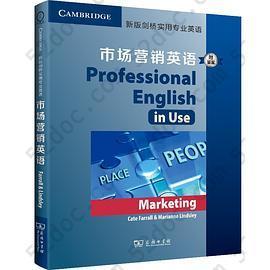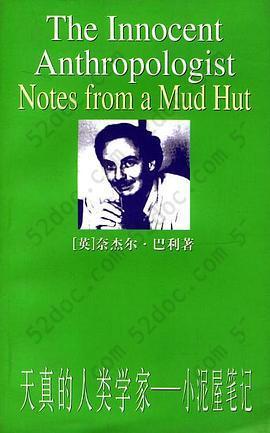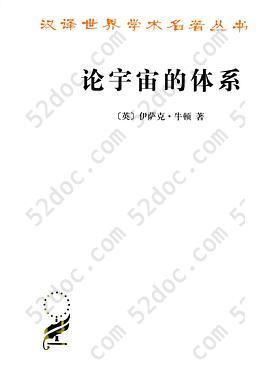注重体验与质量的电子书资源下载网站
分类于: 人工智能 云计算&大数据
简介

新版剑桥实用专业英语:市场营销英语(附答案) 豆 0.0分
资源最后更新于 2020-08-26 06:39:33
作者:〔英〕凯特·法拉尔
出版社:商务印书馆
出版日期:2020-01
ISBN:9787100183246
文件格式: pdf
简介· · · · · ·
《新版剑桥实用专业英语:市场营销英语(附答案)》内容涵盖市场营销理论、市场调研、产品、定位与品牌建立、人员、价格、渠道、促销、包装以及公共关系等商务主题。每个单元都有关键词和表达方式的详解以及练习,供学习者检查和进一步理解所学到的知识。每个单元还设计了“请你参与”部分,为学习者提供情境模拟的机会。本书最后附有练习题答案和索引,供读者自我检测和深入学习。
“新版剑桥实用专业英语系列”是从剑桥大学出版社引进的一套英文影印书,共6本,分别是《医学英语》《法律英语》《工程英语》《市场营销英语》《管理英语》和《金融财务英语》。
目录
INTRODUCTION 6
MARKETING BASICS
1 The marketing mix 1 8
A The Ps
B Marketing a new product
2 The marketing mix 2 10
A The four Cs, As and Os
B AIDA
3 SWOT analysis 12
A SWOT analysis
B SWOT and marketing strategy
4 Marketing strategy and the marketing plan 14
A Marketing strategy vs. marketing plan
B Developing the marketing plan
5 Marketing ethics 16
A Social marketing
B Corporate social responsibility (CSR)
6 The market environment 18
A The micro environment
B The macro environment: STEP analysis
7 Legal aspects of marketing 20
A Legal definitions
B Legal problems
C The Consumer Protection Act
RESEARCH
8 Research 1 22
A Types of research
B Research methodology
9 Research 2 24
A Describing survey results
B Understanding trends and changes
PRODUCT
10 New product 26
development 1
A Idea generation
B Idea screening
C Concept development and testing
D Marketing strategy and business analysis
11 New product 28
development 2
A Workflow
B Product development and optimization
C Test marketing
D Commercialization
12 Brainstorming 30
A The brainstorming session
B Brainstorming techniques
C Suggesting and building on ideas
13 Product and service types 32
A Product types
B Word combinations with ‘goods’ and ‘products’
C Types of service
14 Product life cycles 34
A The Boston Consulting Group Matrix
B Inside the Boston Box
15 Selling products and services 36
A The seller
B The purchaser
C Selling a service
POSITIONING AND BRANDING
16 Branding 1 38
A What is a brand?
B Branding
C Word combinations with ‘brand’
17 Branding 2 40
A Brand platform
B Brand management
C Brand strategy
D More word combinations with ‘brand’
18 Brand values 42
A Common brand values
B Describing brand values
PEOPLE – CUSTOMERS AND STAFF
19 Market segmentation 44
A What is market segmentation?
B How does market segmentation work?
C Common market segments
20 Customer needs and behavior 46
A Maslow’s Hierarchy of Needs
B Consumer Life Cycle (CLC)
C Purchasing behaviour
21 Loyalty programmes 48
A Customer loyalty
B Loyalty programmes
C Talking about loyalty programmes
22 Motivation marketing 50
A What is motivation marketing?
B Staff incentive schemes
C Incentives: travel and events
23 Customer Relationship Management 52
A One-to-one marketing
B CRM technology
C Privacy
PRICE
24 The marketing budget 54
A The marketing budget
B Budgeting approaches
C Return on investment (ROI)
25 Price 56
A Pricing strategies
B Pricing considerations
C The price test
PLACE
26 Logistics and the distribution chain 58
A Moving goods
B Direct distribution
C Indirect distribution
27 Merchandising 60
A Merchandise and merchandising
B Promotional merchandise
C Sports merchandising
D Film, book and music merchandising
28 Trade shows 62
A Why use trade shows?
B Organizing an event
29 Telemarketing 64
A What is telemarketing?
B Outbound telemarketing
C Inbound telemarketing
D Telemarketing scripts
30 Online shopping and mail order 66
A The online shopping experience
B Mail order and the ordering process
31 Personal selling 68
A The sales force
B Personal selling
C The sales process
D Marketing support
PUBLICITY AND PROMOTION
32 Above, below and through the line 70
A Above-the-line
B Below-the-line
C Through-the-line
D Advertising techniques
33 Media strategy 72
A Media strategy
B Media planning
C Media buying
34 TV and radio 74
A Advertising on TV or radio
B The audience
C Dayparts
35 Outdoor advertising 76
A Out-of-home advertising formats
B Effectiveness of OOH
36 The press 78
A Newspapers
B Magazines
C Choosing titles
D Choosing a position
37 Printed documents 80
A Design
B Preparing to print
C The print job
38 Branded content 82
A History of branded content
B Types of branded content
C Efficiency
39 The internet 84
A Internet advertising
B Search engines
C Search engine marketing
40 Buzz marketing 86
A Word of mouth
B Buzz marketing and stealth marketing
C Electronic buzz
D Generating a buzz
41 Sales promotions and displays 88
A Sales promotions
B Point of purchase (POP) or point of sale (POS) displays
42 Direct mail and email 90
A The advantages of direct mail
B Organizing a direct mail or email campaign
C Describing a mailshot
43 Street marketing and sampling 92
A History of street marketing
B Aims of street marketing
C Successful street marketing tactics
PACKAGING
44 Logos 94
A Types of logo
B Logo design
C Typeface
45 Materials and containers 96
A Describing packaging
PUBLIC RELATIONS
46 Corporate communications 98
A The goals of corporate communications
B Corporate values and identity
C Tools of corporate communications
47 Public relations and lobbying 100
A Public relations
B Media relations
C Lobbying
D Inside lobbying
E Outside lobbying
48 Event and sports sponsorship 102
A Sponsorship
B Types of sponsorship
C Word combinations with ‘sponsor’
49 Crisis communication 104
A What is crisis communication?
B A crisis communication case study
50 Corporate blogging 106
A Blogging basics
B Blogs as a marketing tool
Appendices 108
Answer key 120
Index 132
Acknowledgements 143
试读章节:
Introduction
Who is this book for?
Professional English in Use Marketing presents the vocabulary and expressions required to speak about marketing and related fields. It is designed to help those who work in marketing and need to use English. It will also help marketing students preparing for their first contacts with English speakers or studying for exams in English. The level of the book is intermediate to upper-intermediate.
This book assumes you know, or are in the process of learning from your marketing course, common marketing and communication concepts (such as the marketing mix and targeting). Our focus is on the words that are often used by professionals when talking and writing about marketing (such as core target and focus groups) and on English words which are given a special meaning in marketing (such as buzz and loyalty). Every unit uses authentic sources, including marketing forums, company websites, articles from the trade press, marketing blogs, marketing presentations, and case studies.
You can use the book on your own for self-study, or with a teacher in the classroom, oneto- one or in groups.
How is the book organized?
The book has 50 two-page thematic units. The units are divided into ten sections which cover topics such as Product, Price and Place. The first section, Marketing basics, introduces essential marketing vocabulary and concepts which you will need to tackle the more specialized units later in the book.
The left-hand page of each unit explains new words and expressions and shows how the vocabulary is used in real contexts. The right-hand page allows you to check and develop your understanding of the new language and how it is used, through a series of exercises. There is cross-referencing between units to help you develop your vocabulary.
There are twelve appendices, covering examples of confusing words, preparing a marketing plan, talking about numbers, describing brand values, market segments, indirect distribution methods, advertising techniques, TV and radio dayparts and programmes, types of out-of-home advertising, types of magazine, a newspaper rate card, and mailshot items.
There is an answer key at the back of the book. Most of the exercises have questions with only one correct answer. But some of the exercises, including the Over to you activities at the end of each unit (see opposite), are designed for writing and / or discussion.
There is also an index, which lists all the new words and expressions presented in the book and gives the unit numbers where they appear. It also indicates how the terms are pronounced.
The left-hand page
This page presents the key vocabulary in bold typeface for each theme or skills area. The language is introduced in a series of short texts, dialogues, diagrams and tables. Many vocabulary items are illustrated. Each unit has sections indicated by a letter – usually A, B and C – and a clear title.
In addition to vocabulary explanations, this page includes information about typical collocations (word combinations) and register (formal and informal language).
There are also notes on language points, for example where a particular grammatical form is associated with a word, or where the same word may have different uses.
The right-hand page
The exercises on the right-hand page allow you to check your understanding and give you practice in using the words and expressions presented on the left-hand page. There are a variety of exercises including crosswords, short texts, gap fills, matching exercises, and tables to complete.
‘Over to you’ sections
An important feature of Professional English in Use Marketing is the Over to you section at the end of each unit. This is your opportunity to put into practice the words and expressions in the unit by relating it to your professional situation, studies or opinions.
How to use the book for self-study
We suggest all learners start with the Marketing basics section. Learners can then work systematically through the book or pick topics that interest them from the contents page.
Read through the texts on the left-hand page. If you meet words which you consider important and which are not explained in the text, look at the index to see if they are explained in another unit. Do the exercises on the right-hand page and check your answers in the key. If you find you have made mistakes, go back to the left-hand page use as many new words as possible. You should present your ideas out loud and ideally record yourself. The index gives help with pronunciation.
How to use the book in a classroom
Teachers can use this book as a framework for an ‘English for Marketing’ course or to supplement more general course books. The illustrations can often be used as a warm-up activity or as a talking point during the class. Sometimes, the left-hand page may be used as the basis for a presentation, either by the teacher or the learners. Learners can do the exercises individually or in small groups. They can compare answers in the groups or as a whole class feedback session. In the classroom, the Over to you sections can be used as a starting point for role plays, discussions and presentation activities, or adapted to out-of-class projects.
We hope you enjoy using this book.
MARKETING BASICS
1 The marketing mix 1 8
A The Ps
B Marketing a new product
2 The marketing mix 2 10
A The four Cs, As and Os
B AIDA
3 SWOT analysis 12
A SWOT analysis
B SWOT and marketing strategy
4 Marketing strategy and the marketing plan 14
A Marketing strategy vs. marketing plan
B Developing the marketing plan
5 Marketing ethics 16
A Social marketing
B Corporate social responsibility (CSR)
6 The market environment 18
A The micro environment
B The macro environment: STEP analysis
7 Legal aspects of marketing 20
A Legal definitions
B Legal problems
C The Consumer Protection Act
RESEARCH
8 Research 1 22
A Types of research
B Research methodology
9 Research 2 24
A Describing survey results
B Understanding trends and changes
PRODUCT
10 New product 26
development 1
A Idea generation
B Idea screening
C Concept development and testing
D Marketing strategy and business analysis
11 New product 28
development 2
A Workflow
B Product development and optimization
C Test marketing
D Commercialization
12 Brainstorming 30
A The brainstorming session
B Brainstorming techniques
C Suggesting and building on ideas
13 Product and service types 32
A Product types
B Word combinations with ‘goods’ and ‘products’
C Types of service
14 Product life cycles 34
A The Boston Consulting Group Matrix
B Inside the Boston Box
15 Selling products and services 36
A The seller
B The purchaser
C Selling a service
POSITIONING AND BRANDING
16 Branding 1 38
A What is a brand?
B Branding
C Word combinations with ‘brand’
17 Branding 2 40
A Brand platform
B Brand management
C Brand strategy
D More word combinations with ‘brand’
18 Brand values 42
A Common brand values
B Describing brand values
PEOPLE – CUSTOMERS AND STAFF
19 Market segmentation 44
A What is market segmentation?
B How does market segmentation work?
C Common market segments
20 Customer needs and behavior 46
A Maslow’s Hierarchy of Needs
B Consumer Life Cycle (CLC)
C Purchasing behaviour
21 Loyalty programmes 48
A Customer loyalty
B Loyalty programmes
C Talking about loyalty programmes
22 Motivation marketing 50
A What is motivation marketing?
B Staff incentive schemes
C Incentives: travel and events
23 Customer Relationship Management 52
A One-to-one marketing
B CRM technology
C Privacy
PRICE
24 The marketing budget 54
A The marketing budget
B Budgeting approaches
C Return on investment (ROI)
25 Price 56
A Pricing strategies
B Pricing considerations
C The price test
PLACE
26 Logistics and the distribution chain 58
A Moving goods
B Direct distribution
C Indirect distribution
27 Merchandising 60
A Merchandise and merchandising
B Promotional merchandise
C Sports merchandising
D Film, book and music merchandising
28 Trade shows 62
A Why use trade shows?
B Organizing an event
29 Telemarketing 64
A What is telemarketing?
B Outbound telemarketing
C Inbound telemarketing
D Telemarketing scripts
30 Online shopping and mail order 66
A The online shopping experience
B Mail order and the ordering process
31 Personal selling 68
A The sales force
B Personal selling
C The sales process
D Marketing support
PUBLICITY AND PROMOTION
32 Above, below and through the line 70
A Above-the-line
B Below-the-line
C Through-the-line
D Advertising techniques
33 Media strategy 72
A Media strategy
B Media planning
C Media buying
34 TV and radio 74
A Advertising on TV or radio
B The audience
C Dayparts
35 Outdoor advertising 76
A Out-of-home advertising formats
B Effectiveness of OOH
36 The press 78
A Newspapers
B Magazines
C Choosing titles
D Choosing a position
37 Printed documents 80
A Design
B Preparing to print
C The print job
38 Branded content 82
A History of branded content
B Types of branded content
C Efficiency
39 The internet 84
A Internet advertising
B Search engines
C Search engine marketing
40 Buzz marketing 86
A Word of mouth
B Buzz marketing and stealth marketing
C Electronic buzz
D Generating a buzz
41 Sales promotions and displays 88
A Sales promotions
B Point of purchase (POP) or point of sale (POS) displays
42 Direct mail and email 90
A The advantages of direct mail
B Organizing a direct mail or email campaign
C Describing a mailshot
43 Street marketing and sampling 92
A History of street marketing
B Aims of street marketing
C Successful street marketing tactics
PACKAGING
44 Logos 94
A Types of logo
B Logo design
C Typeface
45 Materials and containers 96
A Describing packaging
PUBLIC RELATIONS
46 Corporate communications 98
A The goals of corporate communications
B Corporate values and identity
C Tools of corporate communications
47 Public relations and lobbying 100
A Public relations
B Media relations
C Lobbying
D Inside lobbying
E Outside lobbying
48 Event and sports sponsorship 102
A Sponsorship
B Types of sponsorship
C Word combinations with ‘sponsor’
49 Crisis communication 104
A What is crisis communication?
B A crisis communication case study
50 Corporate blogging 106
A Blogging basics
B Blogs as a marketing tool
Appendices 108
Answer key 120
Index 132
Acknowledgements 143
试读章节:
Introduction
Who is this book for?
Professional English in Use Marketing presents the vocabulary and expressions required to speak about marketing and related fields. It is designed to help those who work in marketing and need to use English. It will also help marketing students preparing for their first contacts with English speakers or studying for exams in English. The level of the book is intermediate to upper-intermediate.
This book assumes you know, or are in the process of learning from your marketing course, common marketing and communication concepts (such as the marketing mix and targeting). Our focus is on the words that are often used by professionals when talking and writing about marketing (such as core target and focus groups) and on English words which are given a special meaning in marketing (such as buzz and loyalty). Every unit uses authentic sources, including marketing forums, company websites, articles from the trade press, marketing blogs, marketing presentations, and case studies.
You can use the book on your own for self-study, or with a teacher in the classroom, oneto- one or in groups.
How is the book organized?
The book has 50 two-page thematic units. The units are divided into ten sections which cover topics such as Product, Price and Place. The first section, Marketing basics, introduces essential marketing vocabulary and concepts which you will need to tackle the more specialized units later in the book.
The left-hand page of each unit explains new words and expressions and shows how the vocabulary is used in real contexts. The right-hand page allows you to check and develop your understanding of the new language and how it is used, through a series of exercises. There is cross-referencing between units to help you develop your vocabulary.
There are twelve appendices, covering examples of confusing words, preparing a marketing plan, talking about numbers, describing brand values, market segments, indirect distribution methods, advertising techniques, TV and radio dayparts and programmes, types of out-of-home advertising, types of magazine, a newspaper rate card, and mailshot items.
There is an answer key at the back of the book. Most of the exercises have questions with only one correct answer. But some of the exercises, including the Over to you activities at the end of each unit (see opposite), are designed for writing and / or discussion.
There is also an index, which lists all the new words and expressions presented in the book and gives the unit numbers where they appear. It also indicates how the terms are pronounced.
The left-hand page
This page presents the key vocabulary in bold typeface for each theme or skills area. The language is introduced in a series of short texts, dialogues, diagrams and tables. Many vocabulary items are illustrated. Each unit has sections indicated by a letter – usually A, B and C – and a clear title.
In addition to vocabulary explanations, this page includes information about typical collocations (word combinations) and register (formal and informal language).
There are also notes on language points, for example where a particular grammatical form is associated with a word, or where the same word may have different uses.
The right-hand page
The exercises on the right-hand page allow you to check your understanding and give you practice in using the words and expressions presented on the left-hand page. There are a variety of exercises including crosswords, short texts, gap fills, matching exercises, and tables to complete.
‘Over to you’ sections
An important feature of Professional English in Use Marketing is the Over to you section at the end of each unit. This is your opportunity to put into practice the words and expressions in the unit by relating it to your professional situation, studies or opinions.
How to use the book for self-study
We suggest all learners start with the Marketing basics section. Learners can then work systematically through the book or pick topics that interest them from the contents page.
Read through the texts on the left-hand page. If you meet words which you consider important and which are not explained in the text, look at the index to see if they are explained in another unit. Do the exercises on the right-hand page and check your answers in the key. If you find you have made mistakes, go back to the left-hand page use as many new words as possible. You should present your ideas out loud and ideally record yourself. The index gives help with pronunciation.
How to use the book in a classroom
Teachers can use this book as a framework for an ‘English for Marketing’ course or to supplement more general course books. The illustrations can often be used as a warm-up activity or as a talking point during the class. Sometimes, the left-hand page may be used as the basis for a presentation, either by the teacher or the learners. Learners can do the exercises individually or in small groups. They can compare answers in the groups or as a whole class feedback session. In the classroom, the Over to you sections can be used as a starting point for role plays, discussions and presentation activities, or adapted to out-of-class projects.
We hope you enjoy using this book.








